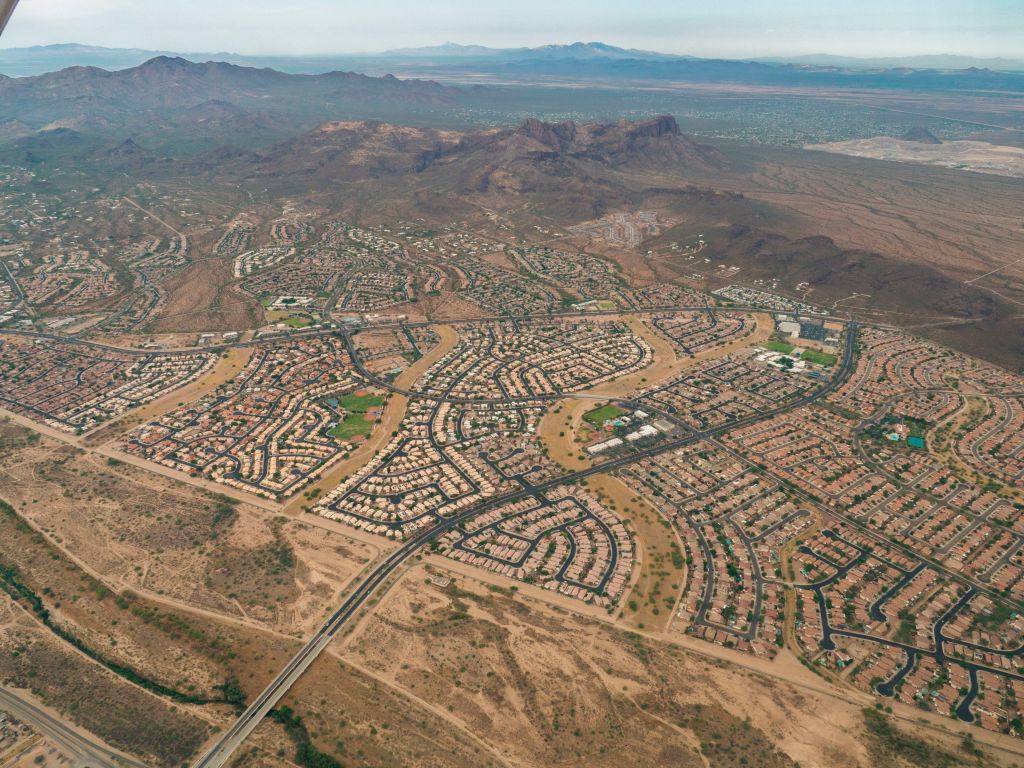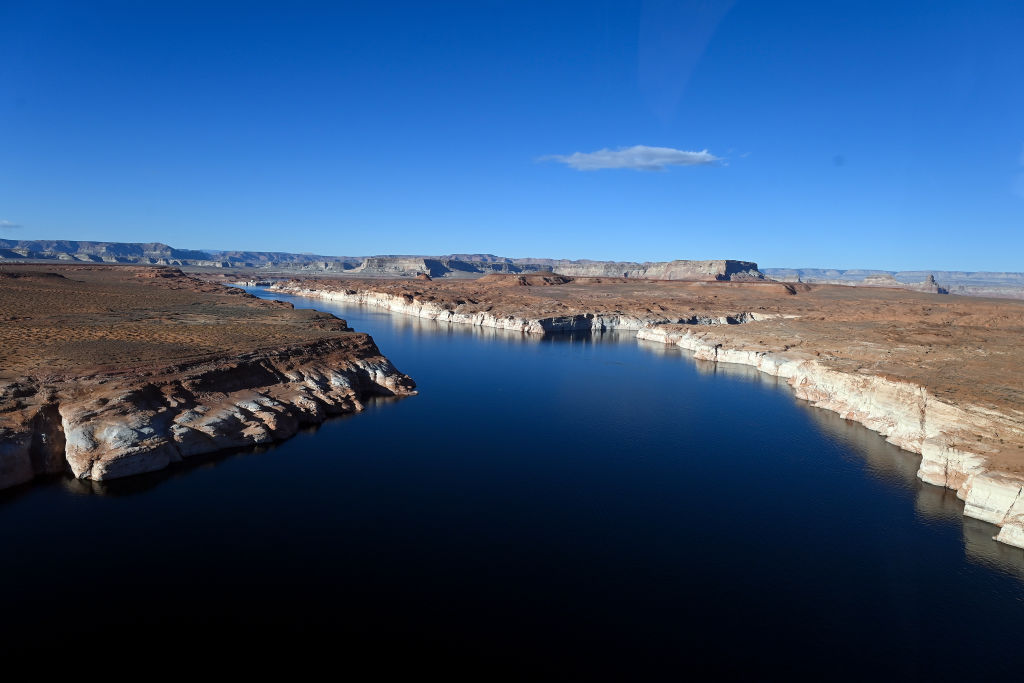
This month, a suburb of Scottsdale, Ariz., found itself in the nightmare scenario for all communities living in the U.S.’ drought-stricken southwest: the water got shut off. Rio Verde Foothills, a community of some 600 homes, sprang up in the 1970s without its own piped water supply. For decades, it had relied on water trucked in from the city. But 20 years into a severe region-wide drought, Scottsdale says it must now conserve its water, which it gets from the Colorado River via a canal, for its own residents. Rio Verde Foothills’ residents are now skipping showers and driving miles in search of drinking water. On Jan. 12, the community filed a high-profile lawsuit against Scottsdale.
The drama in Rio Verde Foothills encapsulates, in miniature, an existential question facing the whole of Arizona: in an era where climate change is shrinking the water supply, should the desert state keep building homes that depend on water from elsewhere?
The answer, given the Rio Verde Foothills ’s current plight, may seem obvious. But that is precisely the question that authorities and developers in Arizona are mulling as they look to sustain one of the nation’s biggest population booms. Since 2000, as the Colorado River has dried up, Arizona has become increasingly reliant on pumping groundwater, which today provides 41% of the state’s needs. Meanwhile some cities, like Tucson, have gone to great lengths to cut back on the amount of water used per resident. Yet at the same time, Arizona is enthusiastically welcoming tens of thousands of new residents—lured by cheap housing and endless sunshine—each year. In 2022, four of the ten fastest-growing counties in the U.S. were in Arizona, according to census data, with Maricopa County, where Rio Verde Foothills is located, at number eight on the list. (As well as families, other thirsty new arrivals to the state include tech companies, whose data centers require millions of gallons of water to keep servers from overheating.)

The boom can no longer survive on groundwater. On Jan. 9, Arizona’s new Democratic governor Katie Hobbs released a report, withheld from the public by her predecessor Republican Gov. Doug Ducey, which shows that a large area west of the White Tank Mountains, to the west of Phoenix, hasn’t got enough groundwater to sustain all the homes—enough for 800,000 people—that developers want to build there. To get approval, Arizona’s Water Resources director told local media, major projects will need to “find other water supplies or other solutions.”
With the state’s river water already spoken for, those “other” supplies, experts say, would likely mean imported water. Pie-in-the-sky projects to bring in water from outside Arizona, such as a 1,000 mile pipeline from the Mississippi River, have bounced around the state legislature for years. As climate change deepens the state’s water crisis, though, one drastic idea has gained traction. In December, Arizona’s newly expanded state water finance board voted to advance a proposed $5 billion desalination plant in Mexico’s Sea of Cortez—potentially the world’s largest—which would pump water north via a 200 mile pipeline. IDE, the Israeli company behind the proposal, says it is now submitting for federal environmental review.
More from TIME
Bring the water
Moving water from water-rich areas to dry ones is nothing new. Canal systems that did just that were crucial to the U.S.’ westward expansion in the 1800s. In Arizona, more than 80% of the population relies on a man-made channel that diverts water from the Colorado River on the state’s western edge to population centers further east. But today, intensifying droughts and population explosions are pushing southwestern leaders to consider huge projects that would bring water from ever further away. In Utah, where migration is driving never-before-seen growth, a legislative committee has floated the idea of building a pipeline from the Pacific Ocean to refill the parched Great Salt Lake. Nevada, which has been growing rapidly for half a century, regularly discusses similar ideas.
Home builders and agribusiness groups see in such proposals the promise of an infinite, “drought-proof” water supply that could sustain the southwest’s growth for decades to come. But critics see a different future, one where imported water fuels environmental destruction and soaring utility prices for consumers, and where U.S. states become dependent on good relations with a foreign country for their survival.
Margaret Wilder, a human and environmental geography professor at the University of Arizona’s School of Geography, Development & Environment, warns that large-scale desalination projects could be used by the real estate industry to justify “much more unsustainable development in the desert in future.”
The prospect of slowing Arizona’s population growth “is the 800 pound gorilla in the room that no water authority wants to talk about, because it’s politically untenable to do so,” Wilder says. As a result, she adds, “desalination is being presented as an inevitable fate for Arizona.”
Importing problems
Environmentalists say the IDE desalination project would harm the planet on several fronts. First, where the water is desalinated on the Mexican coast, the waste salt would likely need to be deposited back into the Sea of Cortez, threatening an area so rich in wildlife that Jacques Cousteau called it “the world’s aquarium.” Second, the project’s pipeline would cut through land home to Mexican people and wildlife, and, on the Arizona side of the border, the Organ Pipe National Monument. Third, the desalination process is hugely energy intensive, and its large-scale use can generate significant greenhouse gas emissions—which are the source of the climactic changes limiting the region’s water supply in the first place.

“We as Arizonans can’t just keep taking water from somewhere else without considering how it impacts the people and places we’re taking it from,” says Cary Meiser, conservation chairman of the Yuma Audubon Society and coordinator of the Sierra Club’s Colorado River Task Force.
Even ignoring those environmental risks, the cost for Arizona residents could be great. At the moment, cities in the state typically pay about $50–$150 for one acre-foot of water—or 326,000 gallons, enough to cover an acre of land in a foot of water. That’s roughly the amount used each year by an average family of three in Phoenix, according to the state’s director of water resources. IDE’s director estimates their desalinated water would cost roughly $2,200 to $3,300 per acre foot. The final price for consumers would be determined, and possibly subsidized, by local governments. But it could become unaffordable for low-income families to live in parts of the state that are reliant on imported water.
A dry path ahead
That cost problem means that, even if desalination provides a bountiful supply of water for Arizona, it likely won’t save the state’s real estate market, says Jesse Keenan, associate professor of sustainable real estate at Tulane University. The industry’s recent success, he says, relies on “a fiction of limitless cheap housing,” sustained by the government’s ability to provide water cheaply. If that can no longer be done everywhere, the cost of properties with stable water connections will spike. And, since people who have to spend more on utility bills have less to spend on mortgage bills, banks may stop lending on homes in regions reliant on expensive imported water. “We’ve reached the limit of the public sector’s capacity to conquer nature with infrastructure,” Keenan says. “Now’s the moment where the private sector will bring discipline.”
Environmentalists are advocating discipline in Arizona’s relationship with water, too. They want the government to focus on cutting water demand rather than expanding supply. That would mean measures to control or limit real estate development, as well as encouraging further water-saving measures by existing consumers, pushing farms to swap out water-intensive crops like alfalfa, and better regulating groundwater use.
Hobbs’s governorship may mark a turning point. She has promised to create a council to oversee the modernization of groundwater rules, and their implementation. Her office says the body will also seek to close loopholes that have allowed developers to skirt a 1980 law requiring proof of a 100-year water supply for projects with more than six homes. (Rio Verde Foothills’s developer, for example, parceled its homes into groups of five or less.)
The governor will face pushback from the Republican-led state legislature, which has repeatedly rejected proposals involving stringent limits on groundwater use in rural areas.
But as more water disputes like Rio Verde Foothills’s crop up, Wilder is hopeful that Arizonans will understand the risks of never-ending expansion into the desert. “I’m not an advocate of pulling up the bridge behind us, but we need to slow this train down,” she says. “We need to start asking questions when people present us with these unproblematic, carefree solutions to the water problem.”
Correction, Jan. 21: The original version of this story misstated the name of the community that had been relying on the city of Scottsdale for its water supply. The community is known as Rio Verde Foothills, not Rio Verde.
More Must-Reads from TIME
- Cybersecurity Experts Are Sounding the Alarm on DOGE
- Meet the 2025 Women of the Year
- The Harsh Truth About Disability Inclusion
- Why Do More Young Adults Have Cancer?
- Colman Domingo Leads With Radical Love
- How to Get Better at Doing Things Alone
- Michelle Zauner Stares Down the Darkness
Write to Ciara Nugent at ciara.nugent@time.com